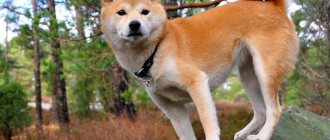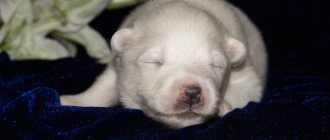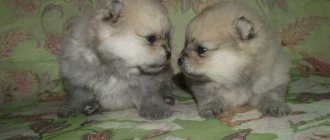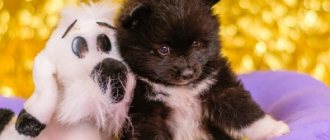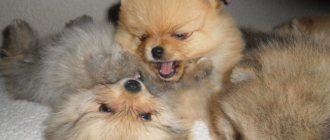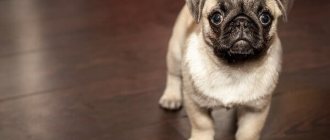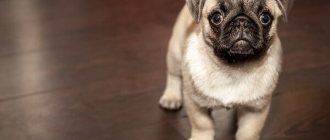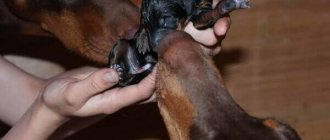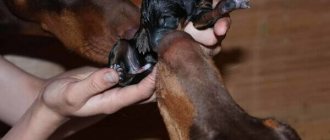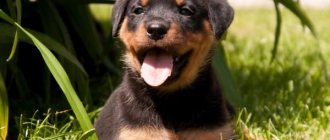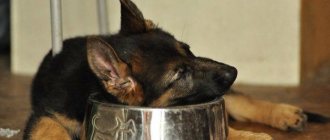Shiba Inu puppies are neat, friendly and very active.
In addition, they are smart, but sometimes they can be stubborn and obstinate.
From a young age, a pet is able to build relationships with all family members, and they will be different with each person.
Shiba Inu puppies are much more active than adult dogs, so they need special nutrition, exercise and discipline.
What do newborns look like in photos?
A newborn Shiba Inu is a small ball of fur that can do almost nothing and is completely dependent on its mother..
The body of a newborn puppy is dense, elastic, but at the same time it is devoid of fat. The mother performs the heating functions for him. In the first two weeks, the puppy cannot see, hear, and cannot defecate on its own.
The Shiba Inu's eyes open 10-15 days after birth..
Most healthy Shiba puppies weigh 400-700 g at birth. The body length of a newborn is 10-14 cm.
Shiba Inu - photo
It is impossible to remain indifferent while looking at the wonderful and fluffy Shiba Inu. So we couldn’t!
Photo: rasfokus.ru
Photo: demotivation.ru
Photo: klkfavorit.ru
Photo: funart.pro
Photo: lapkins.ru
Photo: zen.yandex.ru
Photo: hypecrib.com
Photo: krsk.au.ru
Photo: zen.yandex.ru
Photo: vkbase.ru
Photo: zeleniymir.org
Photo: novosti-n.org
Photo: youtube.com
Photo: porodisobak.ru
Photo: ktozvonil.me
Photo: shiba-faction.com
Photo: klkfavorit.ru Photo: proactions.ru
Photo: lapkins.ru
Photo: demotivation.ru
Photo: klkfavorit.ru
Photo: zen.yandex.ru
Photo: mirsobaki.ru
Photo: kopiberi.ru
Photo: vk.com
Photo: 2ch.rip
Did you like the post? Subscribe to our channel in Yandex.Zen, it really helps us in our development!
How it develops day by day in the first month
| Age (days) | Baby development |
| 1-5 | At this age, the puppy is completely dependent on its mother. All he can do is suck, squeak and crawl around. A newborn puppy lacks vision, hearing and thermoregulation. |
| 6-8 | During this period, the pet is actively gaining weight. By the end of the first week, the dog weighs approximately 2 times more. |
| 9-10 | In the second week of life, the baby not only increases in weight, but also in strength. Now you can easily identify stronger and weaker individuals. |
| 15 | Starting from this period, the puppy's eyes gradually open. He reacts to light, but does not yet know how to navigate in space. The baby begins to develop its own thermoregulation, vision and hearing. Dependence on the mother becomes less. |
| 16-18 | The puppy already sees and hears well. |
| 19-22 | The first teeth are erupting. |
| 23-24 | Interest in solid food appears, the puppy learns to bite and chew. During this period, he begins the first stage of socialization. |
| 25-30 | The puppy is much less dependent on its mother, eats solid food, shows interest in its surroundings, and actively plays with its brothers and sisters. |
This is related to Dogecoin
Dogecoin fans may not like it, but it's a fact - or at least it was until the last rally. Doge's wave set SHIB and all the other clones in motion.
And Dogecoin has no other cryptocurrency, it is the ironic proximity of Elon Musk. To this day, no one can say whether he is serious about Dogecoin becoming a global currency or not. People can rarely be sure of what he says, just because he is a master of irony and perhaps even sarcasm.
However, he is also a very popular and influential man, not to mention how rich he is. His opinion moves the markets. When he criticized Bitcoin, the price of Bitcoin fell. When he praised it, it took off. When he says Dogecoin, DOGE takes off. And when DOGE goes up, so do other coins.
Now it can be argued that SHIB managed to escape from the Doge's leash (pun intended) because they were uncorrelated throughout the last rally. However, it remains to be seen whether this will remain true.
However, DOGE's impact on SHIB is undeniable and has continued throughout 2022.
But DOGE doesn't seem all that attractive right now - it's only a couple hundred percent away from $1, which doesn't seem all that attractive to those chasing the next "100x pearl." On the other hand, SHIB is - for the reasons stated above - more attractive.
Development from 1 to 12 months
The table below shows how the average size of a Shiba Inu changes as the puppy grows.
| Age in months | Size | Weight | Description |
| 1 | 10-14 | 400-600 g | In the first two weeks after birth, the puppy is completely helpless. After the second week of life, the baby can already see and hear. And by the end of the first month, he eats independently and masters the world around him. |
| 2 | 16-18 | 2.3-3 kg | The baby is getting teeth, he is actively growing and socializing. During this period, the puppy is taken away from its mother. |
| 3 | 18-22 | 3-4 kg | Socialization and growth continues. At this age, leaders begin to emerge. |
| 4 | 22-25 | 4.5-5.5 kg | The puppy enters adolescence, baby teeth are replaced by permanent teeth, and the formation of its own immune system occurs. |
| 5-6 | 26-30 | 5.6-8.7 kg | The second stage of socialization, at this age dogs often fight for primacy and leadership. The reason is entering the puberty phase. |
| 7-9 | 27-33 | 9-15 kg | Bitches begin their first heats and growth slows down. The dog does not gain weight so quickly and becomes like an adult dog. |
| 10-12 | 30-35 | 15-25 kg | The end of puberty and character formation. Now she is a young adult dog. |
Types and their description
Standard
The standard Shiba Inu is a small breed of dog, has a proportional build, endurance and high intelligence.
The pet's height is - 36.5 - 39.5 cm, weight -7 - 13 kg.
Dwarf species
The pet's height does not exceed 19–30 cm, weight – 5–9 kg . The dog's build and color are completely similar to the standard Shiba Inu. This breed is not approved by international kennel clubs, so it is known only in Japan.
Mino-shiba (Mino)
The breed, bred in Gifu Prefecture, is distinguished by its bright fiery red color and black eyes.
Pet height – 36–43 cm, weight – 8–14 kg.
Shin-shu (Shinshu)
The birthplace of the breed is Nagano Prefecture. Distinctive features: red-red color, thick and hard fur, dark mask on the face.
San-In
Homeland: Tottori Prefecture, Japan . Distinctive features: black and white or black and tan color and height up to 50 cm at the withers. Less commonly, representatives of the breed have a pale red color.
Basic rules of care
How to care for Shiba Inu puppies:
- The dog's place should be protected from cold and drafts.
- For the first few weeks, the pet should be in a calm environment and have contact only with family members.
- At the initial stage, the dog is fed the same products as the breeder, and only after 3 months of age can the diet be changed.
- You need to walk your young pet 3 times a day. In the morning - approximately at 6-76 o'clock, at lunch - at 13-14 o'clock and in the evening - at 19-20 o'clock. The duration of each walk is 30-40 minutes.
- Brush your dog daily, this will keep its coat smooth and silky and its skin healthy.
- After 6 months of age, the dog can be bathed no more than once every 2-3 months.
- The puppy's eyes and ears should be examined daily for discharge and dirt.
- About once a week, the pet’s ears are cleaned with a cotton swab or disk, and a special lotion is also used.
- If the dog's eyes are clean, then they do not need treatment.
- The pet's diet must be selected in such a way as to provide it with the required amount of nutrients.
- It is highly advisable to brush your dog’s teeth once a week and regularly examine them for the appearance of tartar. If it appears, you should contact your canine dentist.
- Once every 3 months, the dog must be given anthelmintic drugs.
- As early as possible (at about 2-3 months), you need to accustom your dog to trimming its nails.
- Be sure to take your dog to the veterinarian every six months.
SHIB price is “low”
The price of SHIB at the time of writing this article was around $0.000071. This means that for $1 you will get just under 14,000 SHIB. Imagine if it drops to $1. Now imagine if you invest $100 and SHIB converts to USD. Now do the same with $500 and $1,000, all amounts that a good portion of retail investors can afford to spend on the slim chance of it happening.
And you don't have to go to $1, right? If you invest $1000 and the amount is $0.1, you will still make a pot.
This is what social media influencers preach. And what do you know - SHIB actually fulfilled many of these prophecies. As the title of the article says, it has grown by one hundred million percent. Why doesn't he do it again?
Many people who come to the market think so. But in reality, everything is not so simple. SHIB is not cheap these days.
People without investment knowledge, let alone any trading knowledge, may not get to the bottom of the concept behind overall market capitalization. The current number of SHIB tokens in circulation is 549,153,111,315,363 tokens, with a total market capitalization of $39 billion.
To make it easier to understand - if Bitcoin had the same market cap right now, one Bitcoin would be worth $2,068. Considering the current price of BTC, this may seem like a bargain, but remember that the difference is approximately 30 times (give or take). Your $1 investment in SHIB (if it reaches Bitcoin's current market cap) would be worth $30, not a million.
In other words, SHIB is now 1 million times more expensive than it was in January, no matter how many zeros are in front of the numbers.
How to toilet train?
The first thing to start with is daily walks . As already mentioned, you need to walk your Shiba Inu puppy 3 times a day for 3-40 minutes.
During this time, the baby will definitely want to go to the toilet. When this happens, focus your attention on it, praise it, play with it, or give your baby a treat.
At the same time, when the dog is in the apartment, observe his behavior . How does he behave when he wants to go to the toilet? He may be getting restless, looking for a seat or sitting down. As soon as you notice such signs, immediately take your dog outside.
A proper feeding schedule can also help with toilet training . If the dog eats at the same time, then it will also defecate. In this case, you will easily notice the characteristic signs and be able to react in time.
Briefly about character and temperament
The Shiba Inu is a friendly but stubborn dog. At the same time, she is infinitely devoted to her owner, playful and cheerful. Sometimes she is compared to a cat for her love of freedom and independence. Owners often have difficulty getting used to a collar and leash.
Representatives of this breed are clean, well-trained, and intelligent . They are quite easy to accustom to order and walking routine.
In addition, Shiba Inus love to explore new things and sleep in unusual places. Sometimes a dog can climb onto a shelf or into a bookcase and fall asleep there.
Pets are also cunning and smart . They easily learn commands and understand them perfectly, but they don’t always “hear” them. The pet will follow commands only when it wishes.
The same applies to the owner’s demands; if the dog does not want to go somewhere, he will be capricious and resist like a child.
What to feed for the first 3 months?
In the first three months, the puppy's digestive system goes through a period of formation . At this time, it is better to keep the baby on natural food. In addition, meals should be fractional. During this period, the dog is fed 5-6 times a day in small portions.
The optimal daily amount of food for a Shiba Inu puppy should be 5% of its weight.
Cute appearance
The external description of a Shiba Inu is an important part in determining the purity of the breed. According to established standards, dogs can have three coat colors: red, black and tan and sesame.
The color should also contain light areas on certain parts of the body.
The height of the dog at the withers is usually between 37 cm (for females) and 40 cm (for males).
The dogs have an expressive muzzle: clear cheekbones, round brown eyes with raised corners, erect triangular ears.
Note!
Nicknames for dogs for boys - easy, rare and most beautiful names for dogs in alphabetical order
Nicknames for girls' dogs - a list of beautiful, funny, unusual nicknames for large and small dog breeds
Maltipoo dog - everything about the dog from A to Z. Photos, description of the breed, character, maintenance features, prices, reviews
Dry or natural food, which is better?
Both ways of eating have their pros and cons.
Dry food already contains all the necessary substances . In addition, it is much cheaper and easier to feed your dog with it. The owner does not need to select food and cook every day. The main disadvantage of dry food is preservatives and other harmful additives.
Natural nutrition is more natural. Meat, fish, and vegetables give the dog everything he needs for a healthy life and does not contain harmful components .
How to feed correctly and how often?
The number of meals depends on the age of the puppy . The older he is, the less often he is fed. So a 3-4 month old baby is fed 5 times a day every 4 hours.
At 4-6 months, the pet is transferred to 4 meals a day at intervals of 4-5 hours . After 6 months of age, the dog eats 3 times a day at intervals of 6 hours. When your pet turns 10 months old, he can be switched to 2 meals a day.
IMPORTANT!
Meat products should make up at least 40% of the total food.
Another 30% should be fermented milk products, the remaining 30% should be cereals, vegetables, fruits, eggs and offal.
Menu for the week
Monday:
- Breakfast - kefir or cottage cheese.
- Lunch – oatmeal with a piece of boiled veal.
- Dinner - boiled fish with stewed cabbage.
Tuesday:
- Breakfast - yogurt or curdled milk.
- Lunch – buckwheat porridge with liver.
- Dinner - stewed beets with chicken.
Wednesday:
- Breakfast – boiled egg with low-fat sour cream.
- Lunch – scalded heart with rice porridge.
- Dinner – stewed zucchini or pumpkin.
Thursday:
- Breakfast – boiled egg and kefir.
- Lunch – boiled chicken with rice.
- Dinner – stewed cabbage with a piece of boiled fish.
Friday:
- Breakfast – stewed carrots, low-fat kefir.
- Lunch – buckwheat porridge and light.
- Dinner – fresh cucumber, a piece of chicken.
Saturday:
- Breakfast - yogurt or curdled milk.
- Lunch – buckwheat porridge with veal.
- Dinner – boiled egg with oatmeal.
Sunday:
- Breakfast – yogurt or kefir.
- Lunch – rice porridge with liver.
- Dinner - fresh cabbage and low-fat broth.
Vaccination schedule and which ones should be done
Shiba Inu cheek vaccination schedule:
| Puppy age in months. | Vaccine |
| 2 | Complex vaccine against plague, parainfluenza, leptospirosis, hepatitis, enteritis. |
| 4-6 (after permanent teeth grow in) | Revaccination against the same diseases is carried out. |
| 9-12 | The dog is vaccinated against rabies, plague, enteritis, influenza and hepatitis. |
After one year of age, the pet must be vaccinated annually, once a year, throughout its life.
Health and illness
The Shiba Inu is a genetically strong breed. On average, dogs live 12–15 years and often exceed this milestone.
Interesting! It was the representative of the Shiba Inu who was noted as the longest-living record holder. This was a dog named Pusuke: he lived to be 26 years old and was included in the Guinness Book of Records.
However, allergies, hormonal disorders, eye and musculoskeletal diseases are common in the breed. Often found:
- acute reactions to foods or household chemicals;
- cataract;
- entropion: inversion of the eyelid;
- retinal atrophy;
- uveitis: inflammation of the blood vessels in the eyes, leading to decreased or loss of vision;
- changes in pigmentation: vitiligo, early graying;
- hip dysplasia;
- dislocation of the kneecap;
- osteochondritis dissecans: separation of sections of cartilage from the bone and their displacement into the articular cavity;
- shortened spine;
- hypothyroidism: deficiency of thyroid hormones;
- von Willebrand disease: an inherited systemic disease of the circulatory system, characterized by periodic, unpredictable bleeding.
Elizabethan collar
Which dry food to choose?
For a Shiba Inu puppy, premium or super premium food is suitable, designed specifically for puppies of small and medium breeds.
Shiba Inu should not be given food containing soy, wheat or bone meal.
Food is perfect for this breed:
- "About the Plan."
- "Akana".
- Royal Canin.
How to bathe? Cleaning teeth, ears, trimming nails, grooming
Basic rules for swimming:
- It is not advisable to bathe your Shiba Inu baby before the age of 6 months.
- Starting from six months, this should be done once every 2-3 months using special shampoos and conditioners.
- The temperature for swimming should be 38-40 degrees.
- A diaper or a special mat is placed at the bottom of the bath to prevent the dog's paws from slipping.
- When bathing for the first time, there should not be a lot of water in the bath so that the dog does not get scared.
- After the procedure, the pet is wrapped in a soft towel and gently blotted, and then dried with a hairdryer.
The puppy's ears should be cleaned once a week, using a cotton pad or swab dipped in a special lotion . The auricle is wiped both from the outside and from the inside, treating the surface first with a damp and then a dry swab.
Teeth brushing is carried out once a week using a special paste and brush for dogs.
The pet's nails are trimmed as they grow . For the procedure, a special bone cutter is used, which allows the procedure to be carried out painlessly and without injuring the pet. After which the claws are treated with a nail file to prevent cracking.
You need to brush your Shiba Inu puppy daily using a special massage brush . The procedure stimulates blood circulation and promotes healthy skin and coat.
How to train correctly and what commands to teach?
The main aspect of raising a Shiba Inu is the inadmissibility of frequent rewards with treats, otherwise the dog will begin to cheat and beg for treats..
The second important aspect is the inadmissibility of shouting and corporal punishment. The dog must understand the intonation of the owner’s voice and gaze.
First of all, the puppy should be accustomed to its name, and then start giving commands.
The first command a dog should know is “place” . To teach this to your puppy, take him to his place every time he wants to sleep. At the same time, say the command loudly several times.
The next important command is “fu” . Whenever the puppy does something inappropriate, say the command sternly and loudly and distract the puppy with other actions.
The “come to me” command is also considered one of the main ones . Start learning at home. Call the baby by name and say loudly: “Come to me!”, while tapping your hand on your thigh.
When your pet follows the instructions, praise him or give him a treat. A little later, training continues on the street.
Character
Shiba Inus are willful and independent. You should not expect complaisance and admiration for the owner from them. The dog perceives the person as an equal. To some she may seem too obstinate and stubborn, but it all depends on her upbringing. The animal gets along well with its owner and respects him and family members.
Although the dog rarely shows violent joy. She is always reserved and calm. The Shiba Inu does not like constant petting, but sometimes the dogs themselves come to the owner so that he can scratch their back or tummy. Both puppies and adults love to play and be active. However, here everything also depends on the dog’s mood. When in a good mood, Shiba Inus are happy to fetch the ball and run with their owner.
These dogs are not recommended for families with small children. They are quite patient, but they may not be able to stand it and use their teeth for educational purposes. But the Shiba Inu will be a wonderful friend for a school-age child. The Shiba Inu is indifferent or unfriendly towards strangers. Seeing a stranger, the dog takes a wait-and-see attitude. If excessive attention is shown to her, she may become aggressive.
The Japanese Shiba Inu dog breed is distinguished by great intelligence and intelligence. If you instill in a dog respect for its owner, it will obediently obey his commands. You need to start training with simple commands. At the age of 4 months, you can begin to socialize your pet among other dogs.
If problems arise during the training process, it is better for teams to turn to professionals. All puppies are recommended to take a city dog course. If serious problems are obvious, for example, the pet is too willful and even aggressive, then a course of general training and protective guard service will not hurt.
To avoid unpleasant consequences, you should train your Shiba Inu from a young age. It is important to undergo social adaptation in a timely manner. It will help the dog learn to behave correctly with other animals and people, and to react more calmly to irritating factors.
The character of the pet also depends on the breeder. You need to be careful when choosing a nursery. After all, if a puppy initially has an unstable psyche, it will not change in adulthood. It is better for a family with a child to take puppies when they are very young. The sooner he gets to know the children, the more patient and kindly he will treat them.
How to choose?
Advice from experienced dog breeders:
- Never buy a puppy at a poultry market; find a specialist who breeds dogs of this particular breed.
- You should not buy the first puppy you come across; examine several individuals before making a decision.
- Never agree to meet with a breeder on neutral territory; examine the babies directly at the kennel, so you can see the conditions in which the dogs are kept.
- Ask the seller to show the baby's mother and father. If the father is absent, a professional breeder always has his photo.
- When examining parents, you should pay attention to their breed characteristics.
- Be sure to ask the breeder to show the parents' documents, as well as the veterinary passport and puppy card of the chosen pet.
- Clean, well-groomed and well-fed dogs in the kennel are a good sign.
- Examine the puppy itself. A healthy pet has smooth shiny fur, clear gases (no discharge), clean skin and mucous membranes. A healthy puppy is inquisitive and active without being nervous.
